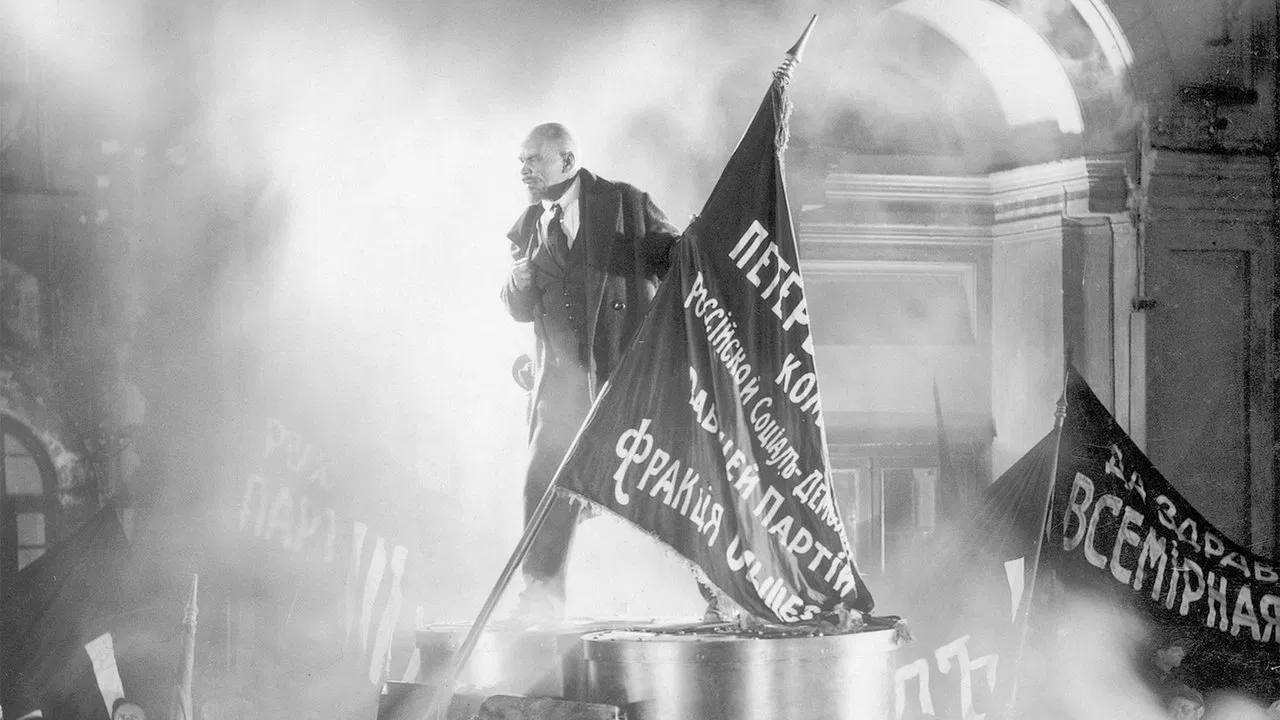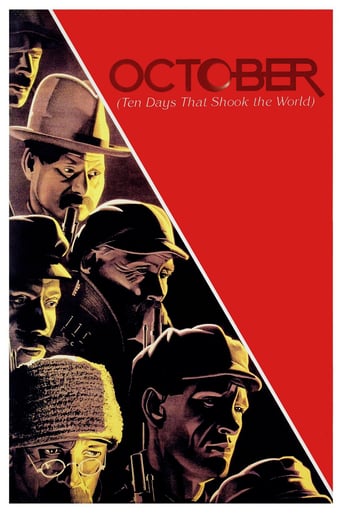

Sergei M. Eisenstein is such an enigma. He's simultaneously one of the most frustrating and most beautiful filmmakers in the history of cinema. His films are blatant propaganda of the most shameless variety, and yet, Eisenstein's mode of visual storytelling is absolutely exquisite. Formally, he's truly one of the greatest masters of cinema to ever live. In that regard, he belongs right next to names like Mizoguchi, Ozu, Bergman, Fellini, and Tarkovsky. In any other regard, he does not. Consequently, whether or not Eisenstein appeals to you will probably depend largely on which facet of cinema most engages you as a viewer: form or content.Those who find that their cinematic standards for quality rely mostly on content will probably be annoyed and unimpressed by Eisenstein. The jingoistic propaganda in his films beats you over the head the instant the film begins, and never relents. Eisenstein had absolutely no sense of things like subtext, character development, or applied themes. The content of his films is about as shallow as you'll find anywhere in cinema. On that level, Eisenstein's films generally amount to a Soviet cheerleading session. That being said, I'm not sure there's ever been a greater master in the history of the cinema when it comes to the visual, formal aspects of filmmaking. Eisenstein was a true artist. His eye for compositions was as masterful as any other filmmaker that ever sat in a director's chair. On a visual level, Eisenstein's films are an absolute treasure and are truly awesome to behold. Therefore, viewers who are most affected by a film's form, and not its content, will likely have a very deep appreciation for Eisenstein.Finally, for viewers like myself, who are equally engaged by form and content, Eisenstein remains the most confusing of all directors. On one hand, I find myself disgusted by the obtrusive propaganda in his films; on the other hand, I find myself completely enamored with his gifts as a director, as a formalist, as an artist. He is very much like fellow Russian filmmaker Mikhail Kalatozov in this way. Both directors polarize viewers for this very reason. I don't think Kalatozov was quite as shallow in the content department as Eisenstein was, and I don't think he was quite as brilliant in the form department, but his overall combination of shallow propaganda and stunning formal brilliance is similar to Eisenstein's.In this respect, "October (Ten Days That Shook the World)", Eisenstein's third film, is very much like any other Eisenstein film. The film was actually co-directed (and co-written) by Grigori Aleksandov, who had collaborated on Eisenstein's debut film, "Strike", as a co-writer. Eisenstein's second film, "Battleship Potemkin", is probably his best known film, and is generally considered his masterpiece. Of these three early silent films by Eisenstein, however, I might choose "October" as the best of them. It's very close, but I give the edge to "October" over "Battleship Potemkin" simply because Eisenstein's visual finesse is even slightly more impressive in "October" than it was in "Battleship Potemkin". With Eisenstein's first three films — "Strike", "Battleship Potemkin", and "October" — I've found that each film is a slight improvement over the last in terms of sheer formal mastery. Some of the shots and compositions in "October" (in fact, just about every single one of them) are simply amazing, not just for 1928, but by any standards at all, from the birth of cinema all the way through today's age of digital filmmaking. And as with any true master of filmmaking, it's not just the utter beauty of the shots that's so impressive; it's the way that the director uses those shots in the syntax of a visual language that only cinema can provide. Eisenstein arranges images and intertitles in such a way as to truly create his own cinematic language, much like Godard would do decades later. The cinematography in Eisenstein's films is gorgeous — the compositions impeccable — but he doesn't move his camera much, and a great deal of the work is done in the editing room. That's where this language is truly spoken. Eisenstein revolutionized the art of editing and montage in cinema."October" opens with an image of revolutionaries charging up a grand set of stairs to topple a massive statue of the Tsar. The stairs look similar to the Odessa steps on which the civilians were slaughtered by Cossacks in "Battleship Potemkin", and so there's an interesting (and possibly intentional) duality here. In "Battleship Potemkin", the people were massacred as the soldiers advanced on them ruthlessly and inhumanly, forcing them down the stairs. Now, in "October", the film begins with the people charging back up the stairs, reclaiming the power that was taken from them under the Tsarist dictatorship. Despite the title of the film, "October (Ten Days That Shook the World)" actually takes place over about nine months, in the year 1917. It begins with the February Revolution, in which the Tsarist autocracy was overthrown and replaced by a provisional government of aristocrats and nobles, which itself was overthrown that same year in the October Revolution. The film spans these two revolutions.If you haven't seen Eisenstein before, it's difficult to explain his style of cinema. It's something that really needs to be seen to be understood. The best way to explain "October" is to say that, if you've seen "Battleship Potemkin", this film is very similar in style to that one. If you haven't seen "Battleship Potemkin" or any other Eisenstein silents, then you probably should — like him or not, he's a massive figure in the history of cinema — and although "Battleship Potemkin" is considered his masterpiece, I think "October" is as good of a place to start as any other.Overall, this is a good film. It's filled with both master touches and conspicuous shortcomings, but the former outweigh the latter significantly. RATING: 7.00 out of 10 stars
... View MoreAs dubious as may be its initial claim to be a completely accurate historical depiction, Eisenstein's October is nonetheless a tremendous creation, expertly weaving its clear message through epic stagings and symbolic montage. Every scene in the film is designed to draw viewers into the Bolshevik ethos, from the heart-wrenching deaths of protesters and their horses at the hands of machine guns and bourgeoisie umbrellas to the triumphant arrest of the provisional government upon the storming of the Winter Palace. Among October's most striking characteristics is its use of montage. Early in the film, scenes of the WWI front show the suffering of Russian troops. Later, as distinguished figures march through the opulent Winter Palace to form the provisional government, the "historical" footage is punctuated by scattered shots of a peacock flaunting its plumage. Likewise, as Kerensky ponders his own grandeur, he is superimposed with a statue of Napoleon, a ruler who famously fell at Russia's hands. Most powerfully, the statue of Emperor Aleksandyr III is dismantled at the start of the film, and seems to reassemble itself as the bourgeois provisional government assumes power. The symbolism is used to great effect, and clearly demonstrates the movie's thematic take on many events in the film. Shostakovich's excellent soundtrack is an incredible asset to October. The score highlights each scene's mood, infusing the film with sadness, excitement, and the joy of victory. Sounds played over the music further reinforce the film's theme. At various points, viewers hear people marching, crowds cheering, and guns rattling. Not only does this engage the audience, but it also gives the impression that in a film of limited sounds, only those made communally–by the Soviet people as a whole–were truly important. October does conveniently portray the Bolsheviks' rise to power in an evidently idealized manner, but it does so with great skill and grace, producing–with the aid of a large budget and thousands of extras–breathtaking (if not wholly accurate) recreations of events in the October Revolution. Soviet audiences must have been truly moved by October's cinematography and score, and future audiences will almost certainly continue to appreciate their work.
... View MoreTo mark the tenth anniversary of the overthrow of Russia's Provisional Government by the Bolsheviks (dubbed 'the October Revolution'), the Soviet government commissioned a propaganda film to be made depicting the events by Sergei Eisenstein. Fresh off the success of his masterpiece The Battleship Potemkin (1925), Eisenstein was seen as the ideal choice to celebrate one of the most significant revolutions in recent history. American John Reed's book Ten Days That Shook the World was the main inspiration for the film's execution and style. The final film, however, was not to the government's liking, describing it as unintelligible to the masses, with Eistenstein taking full advantage of his freedom of artistic expression. The result is a rapid and highly detailed account, full of Eisenstein's trademark fast editing and metaphorical cutaways.It is useful for the viewer to have at least some prior knowledge of the events that took place and the various figures and parties that were involved, as Eisenstein quickly switches his focus from the lower classes, to the Bolsheviks and Lenin (Vasili Nikandrov), and to the Provisional Party and its leader Aleksandr Kerensky (Nikolay Popov). Even with my, admittedly somewhat limited, prior knowledge, I found the film confusing at times. This, however, is more of a damning indictment of my level of intelligence than a criticism of Eisenstein's abilities as a story teller. I would even go so far as saying that modern film- making was created here, as I have to see a pre-1928 film that is quite so technically innovative as this. It is part reconstructed documentary, part artistic interpretation.It may not be quite up to the epic scale of Potemkin or his two Ivan the Terrible (1944/1958) films, but October does include a set-piece that eclipses even the Odessa steps sequence in Potemkin. After the government have beaten back a workers demonstration, many lay dead or dying. The bridge that they lie on begins to open from the middle, and we see a woman's corpse lie motionless, her long hair being lifted up by the opposing side of the bridge. And a dead horse, still attached to its cart, hangs limply from the edge, eventually falling into the river. It's a quite brilliant moment from Eisenstein, who, seemingly without effort, allows the audience to make an emotional connection to a historic event without having to establish any characters in and amongst the chaos. Not the Soviet masters finest achievement, but certainly his most visually impressive, and possibly the most exciting.www.the-wrath-of-blog.blogspot.com
... View MoreCommissioned to honour the tenth anniversary of the October Revolution in Russia, Eisenstein's October is a detailed war film of epic proportions that is shot in chronological real time depicting the events of 1917. A man who was forced to denounce his own work publicly, it is a testament to Eisenstein's strength and dedication to his art that he continued to produce experimental and surreal aspects in his films. And after watching October, it is clear that if Eisenstein had listened to his critics, it would have been a great disservice to cinematic history to have altered his creations.
... View More